A Look At Gearing For Gravel – Part “2X” – by Grannygear
Note- The first article about gearing can be accessed by clicking HERE.
Grannygear’s 2x gearing thoughts, opinions, and wild assumptions.
So now that I had things shifting well at both ends, I needed to decide how to get lower gearing. First of all, how much lower is ‘lower’ going to be? I am not sure, but I expect that unless I get to a 4 tooth gain (basically like having a 12th cog added on to the 11-36 cassette) that I will not be getting enough to make it all worth while. However, I am going to try a half way approach first to see how that works out, but that will be more of an experiment than the final plan.
But before any tools get fit to the hand, let’s look at what my options would be if I stayed 2×11.
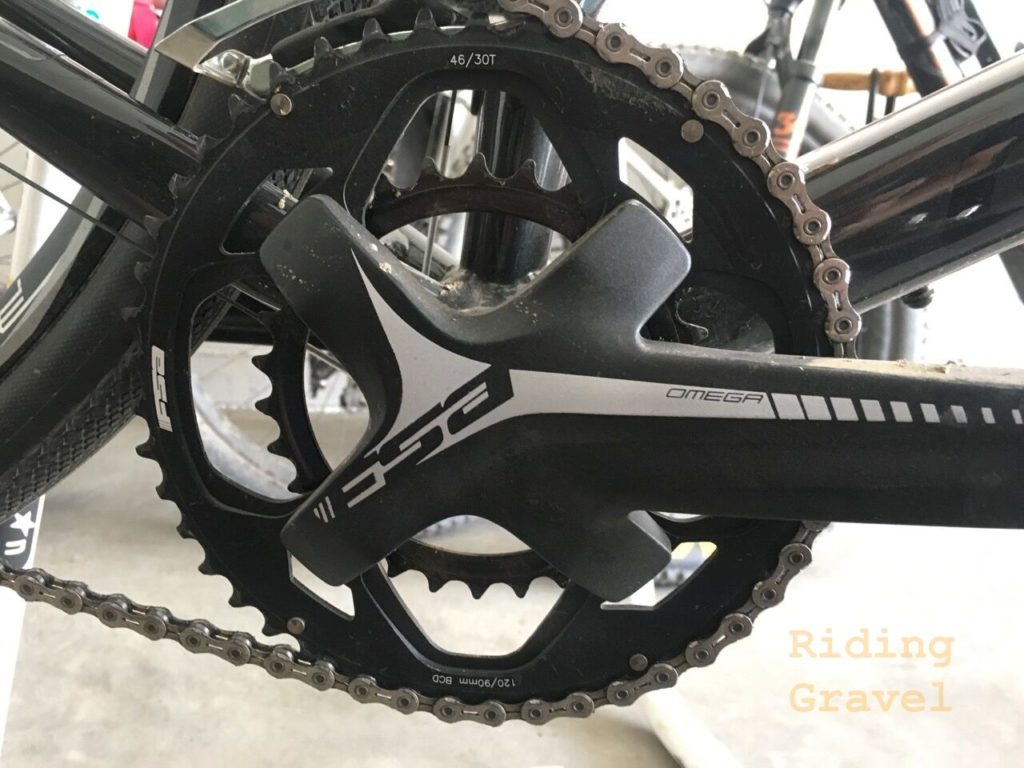
Getting Cranky: What about Sub-compact or ‘Adventure’ geared cranks?
I remember Suntour Micro Drive from back-in-the-days of early MTB. It gave us a reduced BCD crank with a 42/32/20 triple and allowed for some pretty low gearing. Maybe Guitar Ted has some insight as to why this did not catch on, but it made some sense. Perhaps SunTour was in the process of being steamrolled by Shimano’s indexed shifting and programmed cogs that made everything else off the back. (Editor’s Note: SunTour ballyhoo’ed the Micro Drive system as having the same wide ratio as 110/64 BCD cranks but with lighter weight. Typical MTB cranks before this were 46/36/26 or some variation thereof. Micro Drive reduced this to 42/32/22, more or less. Cassette ratios could be smaller with Micro Drive as well. In typical Shimano fashion, they took the idea of a “micro-drive” drive train, made it better, and the industry followed suit.)
Now we have that reduced chainring size happening again in the gravel world. FSA was at the forefront of this with cranks sporting 48/32 and 46/30 chainring sets. Praxis offers a 48/32 combo as well and Easton just jumped in with similar gearing to FSA. The bigger news however is Shimano’s new GRX line of gravel stuff. It was only a matter of time until the big “S” jumped into the fray and gave us options to the silly 50/34 set-ups we have been seeing. So let’s see what the Adventure gearing options are.
- FSA: 48/32, 46/30
- Easton: 47/32, 46/30
- Praxis: 48/32
- Shimano: 48/31 (FC-RX810), 46/30 (FC-RX600)
- SRAM: I am going to set aside SRAM AXS for now, but I will circle back around to it.
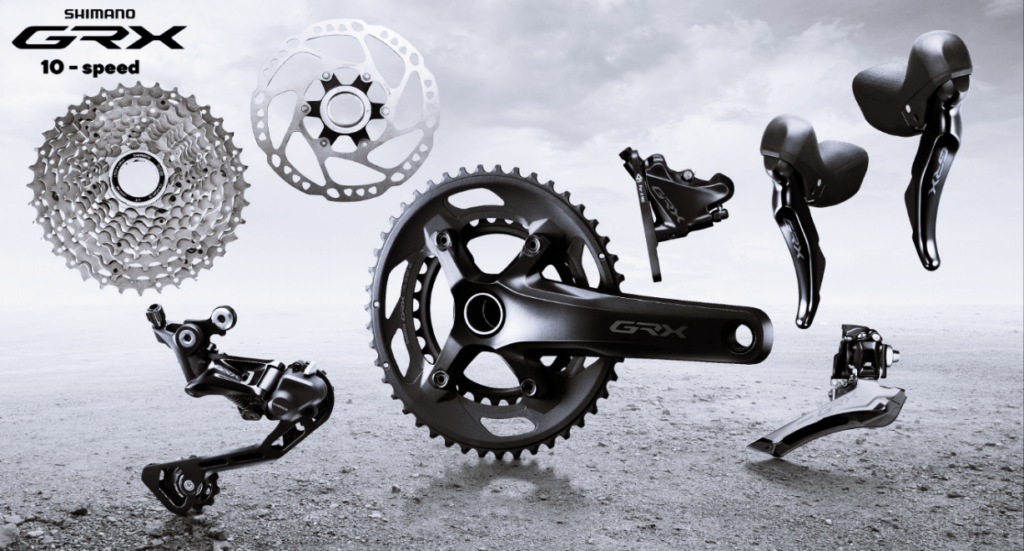
This approach has a lot of appeal as it offers lower overall gearing across any cassette yet retains the basic relationship between chainrings that you would have with a standard road compact double in a 50/34 (16T difference in a 46/30). Interesting that Shimano, a company that loves to have close ratio cassettes, etc, has the biggest ratio difference in the 48/31 crank. With these new tooth counts and ratios the capacity of the normal front derailleur is not too challenged although you need a frame and front derailleur mount that can go low enough to accommodate the 46/30 version.
If I went to a 48/32 instead of my 46/36 and kept the 11-36 cassette, I would gain that 4 tooth difference in my lowest gear. Nice. But, I would be increasing the big ring to the point where I doubt the standard WiFli Rival 22 rear mech could handle the 16T span and keep tension in the smaller cogs/small ring.
There is such a thing as ‘derailleur capacity’. Basically it specifies how much difference the rear mech can handle between all the gear sizes. For instance, consider this scenario: Say you add a bigger cassette over stock so now you need to add some chain length to accommodate that so when you select the big/big combo…big ring and top cog (and you know you will)…you don’t break things. Good to go, right? So now that you can survive that extreme gear combo, you shift into the small ring and begin working your way down the cassette. But now you find that the rear derailleur is beyond its ability to take up the chain slack and by the second to last cog it is out of range and the chain is a floppy mess. Granted, the extreme combos are not something we should do as a rule, but it happens. When I went to an 11-36 cassette, I also reduced my big chainring size, increased my small chainring size, and kept things more or less equal as far as the chain length was concerned and the rear derailleur was able to deal.
Besides the capacity issue, I do not want a taller gear range at all so the jump up to a 48T ring from my 46T is no bueno. And I really only want a single, ‘extra’, lower gear and not a 100% reduction in gear inches across the entire cassette although a 32T ring does get you to a 1:1 low with an 11-32 cassette.
Now consider that a 32T ring is getting pretty small for road work and would mean I would be shifting up into the 48T sooner. Now take that even further and go to a 46/30 combo in that adventure crank. Now that 46T is a sweet spot for me but a 30T small ring is teeny. Man, that would spin out really fast on the road, so the 46T would be used a lot of the time with a good bit of cross chaining I bet. It does allow the 11-32 cassette to give you lower than 1:1 and the 11-34 11spd cassette will get me that 4 tooth gain I am looking for.
Also, that 30T ring may not play well with your front derailleur adjustment. That is not what any road bike parts designer had in mind when they were drawing up a standard road 11spd front derailleur so the cage shape and derailleur swing path is likely less than optimal for a 30T ring. You may find that you do not have enough vertical adjustment in your system to get the derailleur right, even for a 46T, but I have a clamp on type so that is not an issue for me.
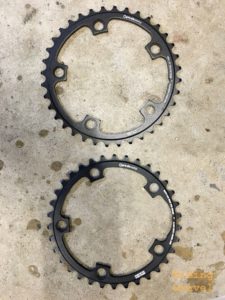
But frankly neither one are what I want. What would I want? How about a 46/36 or 46/34 with an 11-40 rear cassette? Not with the components I have though, unless I could make it work with something like Wolftooth’s Road Link, but with 2x, I still have to deal with the capacity of the rear derailleur to handle chain slack.
So that is where SRAM 2×11 leaves me wanting. There is not really a great solution to getting SRAM 2×11 to be wide enough in range. But, Shimano has been busy. The new, longer cage rear derailleurs in Ultegra and 105 that they now offer have much more capacity. I have been told that they will handle an 11-40T cassette with some massaging to the B Tension screw. It is very likely that I could run a 46/36 and an 11-40 combo as stock bikes are running 48/32 and 11-34 combos off the showroom floor with the new Ultegra clutched der (pre GRX). I have not tried this however, so you are on your own here.
If that works, it actually would be quite good I think, although of course the cassette does begin to get a bit gappy at 11-40.
I will not go quietly into that dark night…
So what if I wanted that crank combo, the one that does not exist, in what I consider to be a modern shifting system (I’m not that interested in some of the esoteric stuff with a square taper interface or the White Indutries crank)? What if I stepped outside the boundaries of programmed shifting and combined a 34T or 32T cog with a 46T big ring? Basically, the way no mainline manufacturer offers it. Well, if I understand this right, a 34T is the smallest ring you can mount to a typical Shimano road crank (110 BCD) so a 32T would be out. But the other day I was riding with a guy on a gravel bike that had an 11-36 rear with a standard Ultegra mid cage and a 46/34 chainring combo (all Shimano). He said he could barely tell the difference in the front shifting.
I mention this because in the world we live in, all the main players do not support chainring combinations that are not ‘factory’. So the 46/34 combo is coloring outside the lines. No one will say it will not work, but no one says it is just fine either.
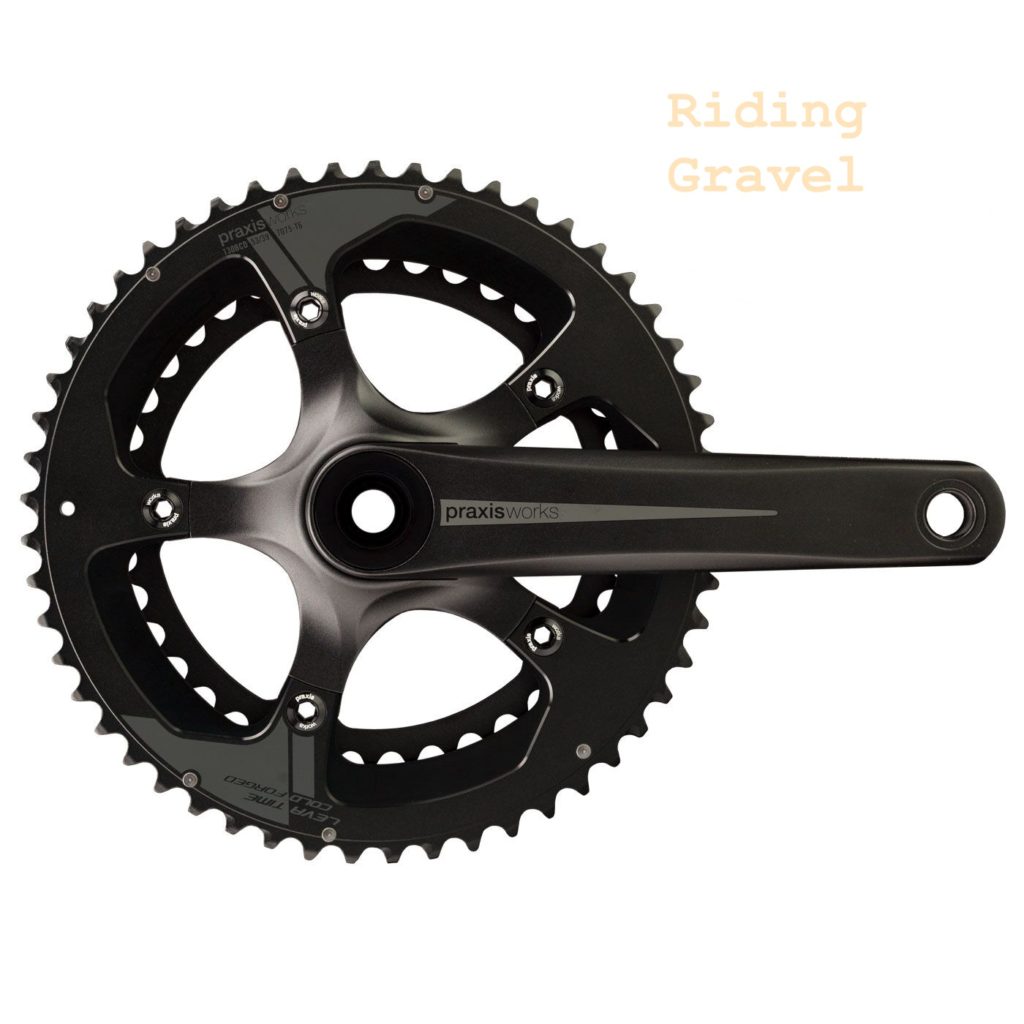
So to play with this a bit, I asked Praxis to send me a 34T chainring as well as the standard ‘approved’ combo of the 46/36 that I had just installed and was a proven shifting system. We talked on the phone at length about this and they were fine with the experiment, but of course they do not promise that the results will be at the same level as what they sell as matched sets. If I was ready to accept that a 34T small ring and a 36T top cog was enough of a low gear, then this could be a way to go, although I will be pushing the capacity of the rear derailleur to handle chain slack.
Results? Shifts great. Can I tell a difference? Yes, but it is soooo slight that I would call it just fine. How has it been as far as getting a lower gear? Well we are only talking a 2 tooth difference here but yes, it is noticeable. It makes nose-of-the-saddle climbs more doable and yet the 34T ring is fine on the road, speed wise. For my area, and if I had a Shimano crank, it is what I would do if that was the limit of things. 46/34 and 11-36.
But here is the rub, for me at least. Praxis does not sell 2x chainrings separately, so you cannot buy a 46T and a 34T (or 32T, etc) as a set. You would have to buy both sets that had what you wanted in them and use only half each time. Hardly reasonable cost wise.
You can get Shimano rings separately for a Shimano crank, so there is that and frankly Shimano is what 95% of riders out there have anyway, right?
So in Praxis land (and others), really it makes more sense to go with the 48/32 crank and the 11-34 rear gears…easy to buy, you know it works. It’s just not to my wants.
So let us move to the other end of things. What can I do with cassettes?
I am already at the limit of that standard SRAM WiFli Rival 22 rear derailleur. An 11-36 is about it. Now I could run that Wolftooth Roadlink but here is the problem…that does not expand the derailleur capacity which, if you remember, is the ability of the derailleur to handle the chain slack when in the small ring and lesser cogs while still not tearing things off the bike when in the big/big combo (Roadlink was intended more for 1x). As well, I am not crazy about the idea of stacking bendable aluminum bits between my frame and my derailleur which is what is happening if you add a Roadlink to an existing replaceable hanger. It does work though and there are many happy riders on Roadlinks.
Well then, let us just swap to a rear derailleur with increased capacity, like a MTB one with longer cages and geometry that is happy with 40T cassettes. Not so fast. Almost none of this turn-y, gear-y, shifty-bits stuff plays well together. It’s like no one thought of this adventure/gravel bike stuff and never imagined that we would want this range of gearing on a road based system. You have to match the amount of cable pulled with each *click* of the shifter to the amount of travel each *click* moves the rear derailleur or it’s a catastrophe.
The amount of cable pulled by the SRAM 2×11 road shifters is the same as the older SRAM 10 speed MTB stuff, so you should be able to mix and match certain road and MTB rear derailleurs across SRAM groups (more on this later). Shimano does not allow for that. The Shimano 11 speed road shifters do not speak the same language as the Shimano MTB 11 speed rear derailleurs. Further, MTB and road SRAM 1×11 is not the same. And Campy is different. Really different. And…it’s like this dysfunctional family where everyone can only deal with their own stuff and cannot tolerate anyone else’s stuff. Talk to the hand! It makes it really hard to get wider range 2x gearing on a gravel bike by simply bolting on a longer cage rear MTB der. Now Di2 makes it easy. Road Di2 brifters will talk to an MTB Di2 mech. Kind of handy, that.
Getting back to SRAM, I had heard that you could run a SRAM 10 speed MTB rear derailleur with the Rival 22 road shifters, allowing for bigger cassettes due to the longer cages and bigger chain capacity of MTB stuff. So I grabbed an 11-40 Shimano cassette, put it on the Lynskey and unbolted the Rival 22 mech. Now one awkward thing in my quick experiment was that SRAM 10 spd MTB rear derailleurs have no cable tension adjustment barrel, or at least the ones I have do not. The cable tension adjustment is at the bar mounted MTB shifter. Road shifters do not have this. So for this experiment I would have had to cut my rear shifter line and splice in a barrel adjuster to make it right. For the time being I just went without and left the chain length as is. I grabbed an old XX SRAM rear derailleur from the 10 speed days and bolted it up. Was there ever a rear derailleur that had a more frustrating cable fastening screw position? (Editor’s Note: Maybe old SunTour Accushuft rear mechs, maybe…..)
Anyway, that done, I found it shifted the 11-40 pretty well even though the chain was a link too short for big big. I think this would have worked fine actually, but I got to thinking. When was the last time you saw a SRAM 10 speed rear derailleur for sale? In a bike shop? Bet it is dusty. So that did not seem like a way to go if I am thinking of the future. But it would have been interesting.
So there we are with 2x and SRAM. The only reasonable way I see to get the low end I want with my SRAM stuff would be with a crankset I am not all that jazzed about, that being the 46/30, or perhaps creating my own with a 46/32 combo and that is hard to do unless you can get the chainrings separately.
Where that leaves me with SRAM is on the doorstep of 1X’s house, ready to press the doorbell. ‘Ding Dong’…The secret password is “One”. And that is where we go next. But let’s look at Shimano based systems, which offers more flexibility in 2×11.
Stay tuned for Part 2X (part duex) coming soon.



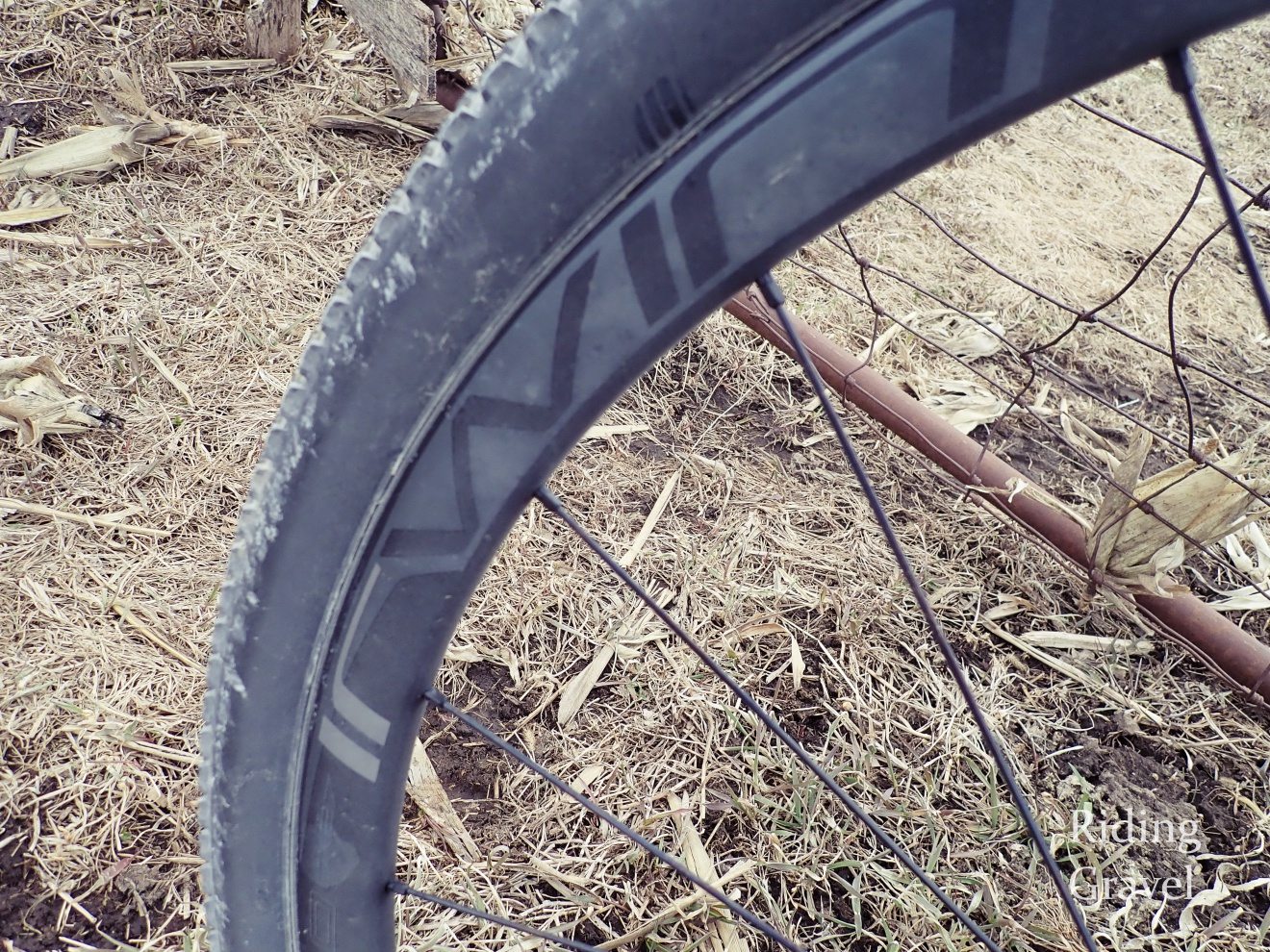
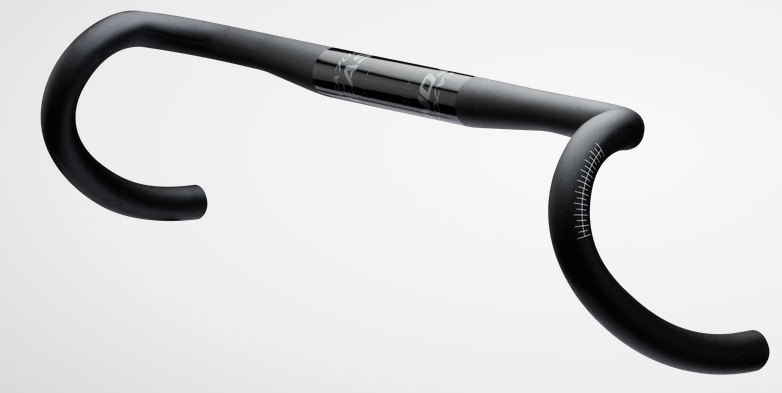
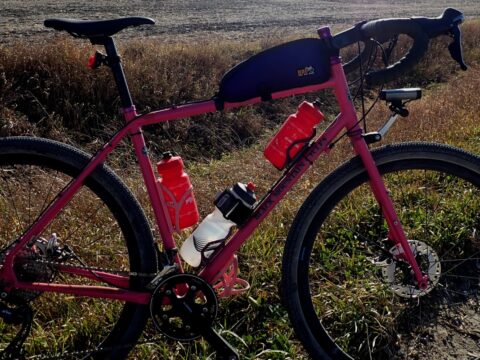
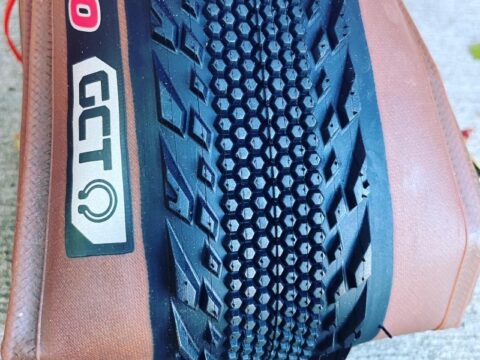
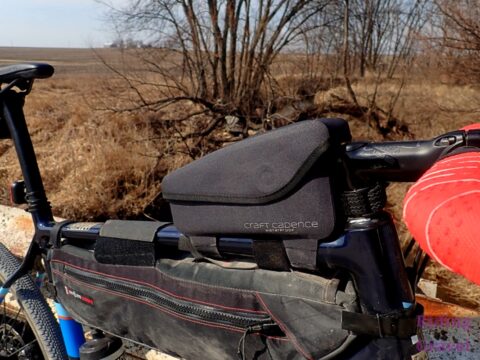
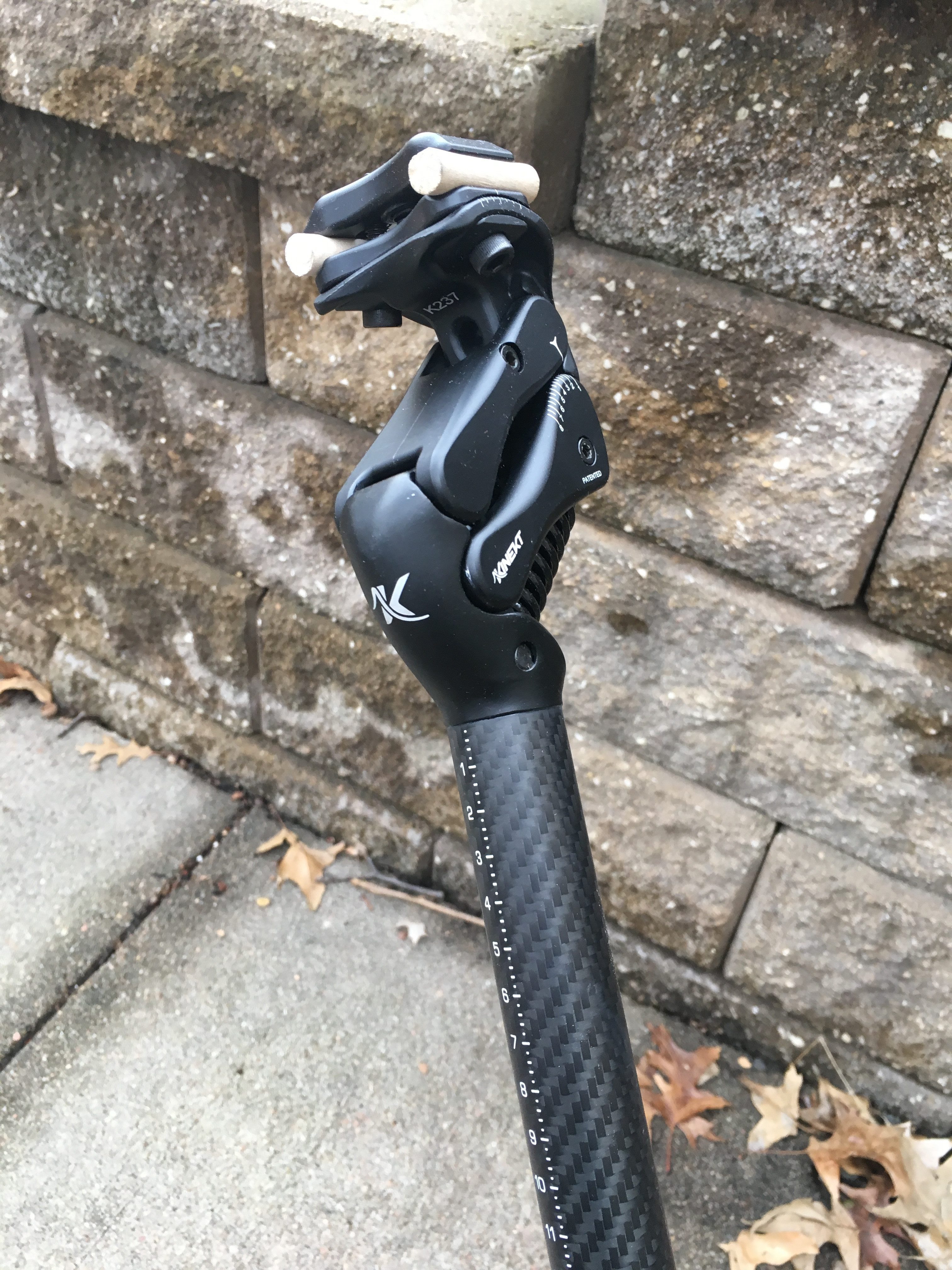
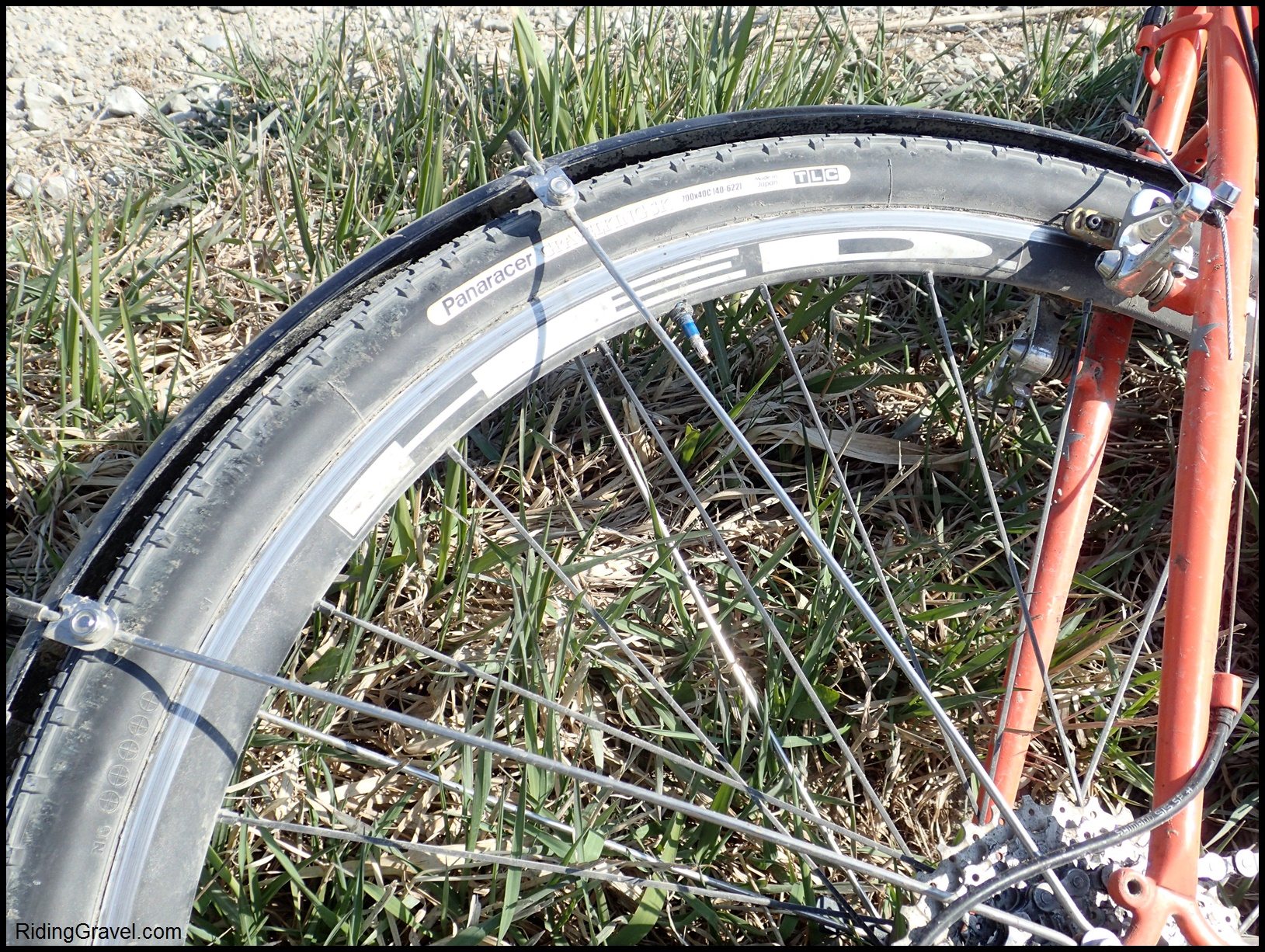
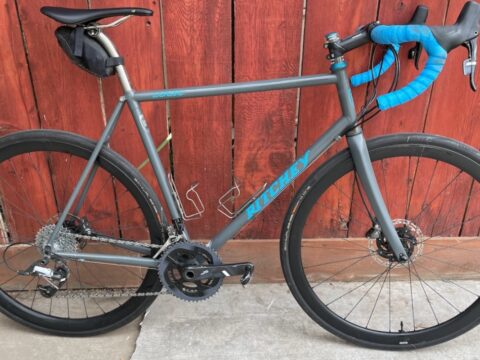

Great analysis! I’ve been through the pain of this years ago. Now I use a 2×11 setup with a mix of components:
Sugino OX601D crankset with 42/26T chainrings,
Shimano 105-5800 11sp shifters,
Shimano 105-5800 long cage rear mech,
Shimano U5000 Metrea front mech,
SRAM 11-32T 11sp cassette.
It all works great together. The rear mech has enough capacity to serve a 32T sprocket. The front mech is fully compatible with 11sp Shimano shifters, yet it comes with a more curved and shorter cage – better suited for smaller chainrings. The crankset is very special indeed – it’s a modern, two-piece road crankset (for a 68mm BB shell) with two BCDs (110/74mm) so it can take those tiny MTB chainrings. Of course this setup is not for racing, but for my riding style it works great.
What bike are you using
I have Sugino OX2-901D cranksets (which I like) on both my road and gravel bikes (46/30 and 44/30, respectively, with, on both bikes, 11 speed Ultegra and, when needed, SRAM 11-36 cassettes).
You run 42/26T chainrings on Sugino 601D — what brand chainrings? TA Specialites? Do the subject chainrings have “ramps and pins”? Did the chainrings mount with the hardware (bolts) included with Sugino crankset (or were new/different bolts required)? Did you have any problems with chain hitting chain stays?
I am most interested in your setup (please reply — what brand chainrings?). I think 40/26 (or 38/26) would be ideal on my gravel bike.
If you arent needing more speed than a 38t or 40t chainring can deliver on an 11 speed cassette with an 11 or 10 smallest cog of a 32t cassette, why not use a 1 x 12 system with a 38t or 40t chainring and a 46 or 50t largest cog cassette? I’d like to kmow your thoughts.. thanks!
I understand that you can’t look at all cranksets out there but Sugino has been around for quite some time and offers their OX901D classic compact + crankset in many chainring configurations. 46/32 happens to be one of them. I have their crank on my gravel/cross bike and I have been very satisfied with it. It also happens to be one of the only cranksets out there easily compatible with the BB90 bottom bracket.
Sugino – and their excellent OX601 & OX901 ranges – definitely deserved a shout out.
They were pioneering 48/32 and 46/30 WAY before FSA, Easton and Praxis found it a bandwagon worth jumping on.
Sugino…good to know. That was not even on my radar. The next 2X installment actually finds me getting some peace of mind with the 46/30 crank even with its shortcomings. It’s not what I really, really want, but it’s not as bad as I expected it to be.
gg
I have a question. This is a question referring to smaller gearing on a road-bike. I have this idea of getting easy gearing, and also a low weight set-up, as it’s a bike intended for climbing, and especially being able to spin relatively well on 10%+ inclines. The idea in my mind is also to make it relatively cheap, in terms of $/g.
Carbon Zayante 48/32 crank, Sram Force 22 shifters, Sram Red 22 front derailleur, Sram Red Force 22 rear derailleur, Sram Red 22 brakes. The brakes and cranks are there for quality reasons, the shifters and rear derailleur are same quality as Red but just a bit heavier, but not much. My ideal cassette would be the Shimano 11/34. The reason I like this particular cassette is because of the way the gears are spread over the cassette (11-13-15-17-19-21-23-25-27-30-34), there are relatively a lot of gears you would use when climbing (19-34) which are often even less than 10% apart, enabling almost fixed cadence when climbing which is sublime and can’t be found on other cassettes. As normally, more of the time I don’t spend much time in the 11,12,13,14 gears anyway, I think this is perfect. And on flat road you never need to shift to the small ring with this set-up. Add to that a 32/34 smallest gear, which is smaller than 1:1, and you know even the steepest inclines will be as comfortable as possible for road riding.
However the issue with this set-up is the Sram Force 22 rear derailleur, it has a capacity of 37, while this set-up requires (48-32)+(34-11)= 39 capacity. Also the 34 back is larger than the 32, but I have read you can dial this with a b-screw, even for a 36t biggest cog, so that’s not the issue. The issue is just that the Sram Force 22 rear derailleur does not have the capacity, so my final question is, how and when would this problem manifest itself? Only when I use small/small, which is never necessary with this set-up as you can go quite small in the big ring, or will it just give other problems?
Btw, I know Shimano Ultegra can do this, but then you lose out on the weight savings of the Sram groupsets. Please let me know what you think.
@Droitaubut- A couple of interesting points there. First, you bring up cadence and gear spacing. This is something a lot of folks miss when they suggest 1X set ups which compromise on this important point. For folks that spin more than mash, it is paramount to have closely spaced gears on the cassette. 1X often will not have this, especially on the lower end of the gear range.
And chain tension does play a role, as you are picking up on. Here’s the thing- many of us completely understand and know why we should not ‘cross chain” when riding. But how many of us find ourselves doing just that when we are seeing spots in front of our eyes on that 12% grade or just afterward when we crest the hill and are chasing down the rider in front of us like a racing greyhound? (Raises hand here)
So, while you may understand full well that you will “never use those gears”, my bet is that at some point you will find yourself there and then what? That’s why it isn’t a good idea to go into a situation where something is not recommended and thinking you’ll never go there, because it may cause issues that no one wants to have occur.
But “theoretically speaking”, you are correct. I’m just not convinced that in real world conditions you’d never have an issue.
Ah…… It’s questions like these that make me think triple crank sets are not as dumb as we were led to think they were.
@Guitar Ted, thank you for your reply. I am indeed more of a spinner than a smasher, on the flat, I like my cadence to be 90-100, on 0-6% inclines 80-90, on anything steeper than 6%, 70-80. So, generally I like the change in cadence when shifting to be about 10%, and for sure less than 15%. The 11-34 cassette doesn’t satisfy that when shifiting from 11 to 13, and from 13-15, but those are the shifts I would make least, or only in a descent when you need a gear that’s a lot taller quickly (and descents also don’t take quite as much time as climbing). Hence it’s more important that the gears from 15-34 are all less than 15% change in cadence, many even less than 10%.
On the chain wrap issue, still interesting what actually COULD happen if it goes wrong and you go over the capacity… The reason I think it wouldn’t happen is that I never cross-chain, and actually never use the outer two cogs in that sense. So for example no 48-34 or 48-30 with above described combo, but more importantly, shifting to an easier gear will go from 48-27 to 32-27, and then shiting to harder cogs to get the right gear, and in this cassette, only the 11 would cause problems, so there is actually only 1 gear you should never use, it’s the 32-11, as 32-13 (which I don’t think I will ever use), exactly fits the 37t chain wrap capacity (34-13)+(48-32)=21+16=37. Do you think in this case the risk isn’t as severe?
@Dr J, @Phil S , @Schadenfreude – Concerning the Sugino offerings: While they are typically attractive and have nice gearing options, Sugino OX series crank sets are not easily found all the time and when they are, they are expensive compared to the competition. That said, they deserve to be mentioned and should be more widely known as they have excellent quality and the fit and finish is top notch.
Your suggestions are noted. However; as rightly pointed out, we cannot look at every crank set. So we are focusing on what is coming on Gravel/Adventure bikes as stock, or on easily sourced offerings for aftermarket “fixes” to the issues at hand, (Wolf Tooth being one example there)
Thanks for the comments!
@Droitaubut…What made the 2X SRAM work for me as I pushed the Rival 22 rear der past it’s suggested limits was the 46/36 chainset as that kept the highest high and lowest low in check as far as der capacity. As you said, it is not the 34T cassette that is the issue as much as it is the 14T spread of the chainrings.
However, if Red 22 is rated to handle an 11-32 with a 50/34, then you should be good. You are gaining 2 teeth in the rear but dropping two teeth in the front so chain length should not change. If the B tension screw is not enough to handle this, then try a Roadlink.
SRAM makes it so hard as they want everyone to go AXS which means E shifting and high cost. I just went to the SRAM site and all I see is AXS for road. Thanks SRAM. Sucks to be us now with older systems, I guess.
gg
@grannygear, the only problem is that I am not dropping 2 teeth in the front, whether you got 50-34 or 48-32, both have a 16t difference. According to people the Force 22 rear derailleur has a long B tension screw and can even be made to work in the way you mentioned, i.e. 46/36 with 11-36, but that’s also within the chain wrap capacity. Even 46/34 would be within the chain wrap capacity. So I guess the only gear I can’t use in the 48/32 and 11/34 combination is the 32/11 gear, as the next gear up is 32/13, and that one is within chain wrap capacity. Do you agree avoiding this gear is quite easy, as it’s the least likely gear you will ever use? You won’t shift from 48/11 to 32/11, as you would first go down the cogs of the cassette if you want an easier gear, to 48/13 etc.. and if you are on the inner 32t ring, and you are at 32/17, and you want a harder gear it’s roughly time to shift to the big ring already, and then you’re not even at 32/15 or 32/13 yet… Finally do you have any idea what would happen if you go over the recommended chain wrap capacity?
@Peter van ‘t Westende…you are dropping two teeth in front. 50/34 to a 48/32 is two teeth smaller. Then you add it back with the jump from a 32T to a 34T. I might not have expressed that well or maybe I am missing something here. The point to that is your chain length should not need to grow as you are wrapping the same amount of total teeth in the big/big combo. Of course that does not help with der capacity as well as the ability of the der to shift into larger and larger cogs (hence the Road Link). Those are different deals. That is where that 36T small ring is so nice (among other things). It helps with chain slack issues in the small ring.
Yeah…who would ever stay in the 32/11 combo? I don’t run in the small/small even on a stock road bike. Noisy as all get out. It’s like the clueless noob cyclist’s theme song…riding along with the chain all crossed over and rubbing on things. Don’t be that guy…I am sure you are not or we would not be having this chalk talk.
Exceeding chain wrap capacity would just mean a floppy chain in some of the smaller cogs when running in the small ring, as we just discussed.
Or.
If you shorten the chain enough to where it does not have too much slack in the small/small, combo, then one day you will shift into the big/big combo and, since the chain is now too short to make it all the way around all that, it will be a noisy and expensive moment in your cycling journey as the der says “this far and no farther”.
That is to be avoided. Better to have a floppy chain in smaller CR/Cog combos. That can be a bother, reminding you to shift the big ring, but is not likely to have you walking home.
Make sense?
gg
It is dropping two teeth in the front, and I guess that makes the chain shorter (50×34 versus 48×34). However, it still goes over the chain wrap capacity, 39t versus 37t. What you gain with a smaller big ring, you lose with a smaller inner ring in that sense. So chain gets, shorter, but more chain has to be catched by the derailleur in the smallest gear.
I agree with you that the 46/36 inner solves this issue, and gives you more range in the cassette. However, I think if you compare the 11-34 cassette with the 11-36, I think the way the 11-36 gears are spread is not very nice, especially not for climbing. The reason I am making it a bit difficult is going for weight savings using SRAM components. However, if I would go down the Shimano route, you could easily do 11-34 with 48/32 totally within the recommended limits. As you don’t seem to worry about weight, why not do that?
I think shortening the chain is not an option, because if I am not thinking straight I may end up in the big/big combo by just riding a gradually increasing incline, and shiting one gear easier automatically. If the only issue with a too long chain is a sloppy chain I don’t think it will be a problem. So think I could do this experiment. Hopefully it still somehow helps that the chain is shorter with a 48 big ring compared to 50, and if just not shiting into the 32/11 hopefully it will work just fine.
On my Shimano cassettes I swapped my 11T threaded lockring for a 12. I rarely used the 11 with the big chainring and figured I’d rather have a gear that I’d use more often. It slightly reduces the slack if you accidentally end up small/small.
Apart from Sugino, there is now also the similar and cheaper IRD Lobo adventure crankset. You can choose the crank length and chainrings individually for a custom setup. Inner can be 28-32, outer can be 40-46. http://www.interlocracing.com/crank-arms-chainrings/lobo-adventure-crankset
Main issue with the IRD Lobo is the Q-factor. The Lobo uses a wider mountain-bike Q-factor to support 73mm BB shells, where the Sugino only supports 68mm.
I’m running a sram 48/34 crankset with an 11-40 and a sram 10 speed GX long cage using sram bar end shifters, nothing fancy, but the whole thing works and shifts like a charm.
It’s the perfect range for the steep loose climbs in the mountains where I live and plenty of room to speed down the other side.
I have a 46/34 Ultegra 8000 chainring paired with 11-40 XT cassette with an Ultegra RX derrailleur and works absolutely fine.I love it and won’t change it. I think it is always better to have more than less just in case.
I used to ride 11-34 cassette but for really steep climbs or for really long days or even for bickepacking the 1:1 ratio was a bit tight.
I don’t usually use the 40t but I know I have it down there, and it is (in my case) an must when you go to unkown places where you don’t usually ride.
The only ‘problem’ if I can say so, it’s that you can no use de 46×40 as the chain is not so long, so better watch out.
Good to know, 46/34 Ultegra has been my jam for a while now. Usually paired with an 11-32 and now 11-34 cassette. I can see myself expanding to a larger cassette in the future, and I’ve been hesitant to use an XT rear mech with a Tanpan.
gg – I know you don’t want to get into too many aftermarket solutions, but WickWerks makes some cool chainring combos (42/34 & 41/33) as well as a device to effectively make the braze on FD tab lower.
I have the GRX 46/30 and 11-34 cassette and it’s great! On the road in the 46 you are in the lower half of the cassette for a nice chainline.
I find no down side to the 30T frontvring when things get really steep. With the GRX front mech (2.5mm wider chainline than road) shifting is spot on…
I also did this and didnt even have to reposition the ultegra front mech, using the original chain length its a bit slack in the last few low gears, so I need to remove two chain links, but you dont ride there anyway so it no issue. 46/30 GRX600 & 11-34 with utelgra is fine
Also have a 1×40 with 11-34 and a 1×9 38 – 11-42
all work absolutely fine, I say look at the ratios irecon a o.88/0.81 is the lowest you should need and 38 – 11 is fine for top gear too on my 1×9
But 2 x is faster for sure as i’ve tested the lot…
So, are you saying that the chains you buy, are too short even uncut? I think the 11-40 cassette is a nice cassette in terms of spread of the gears, like the 11-34 is as well. The 11-36 I don’t like actually. It would be a really good idea for Shimano to produce an 11-38 casette with a nice spread, in similar style to the 11-34. If you combine this with an 48/34 up front you need 39t chain wrap capacity, while with an 48/32 you need 41t chain wrap capacity, which the RX derailleur has shown to be able to manage. I think the Easton 47/32 is also a nice front combination, but I don’t like their marketing saying 48/32 of Praxis doesn’t shift as well, as all the testers were impressed by the Praxis set-up. Have less than a 16t difference up front is also attractive, certainly for reasons of compensation shifts.
I’m running a 46-34 and 11-36 combo as suggested by the author here, and while I haven’t experienced any other gravel gearing, it suits me well. The crank is an FSA Gossamer with a Shimano 105 5800 front derailleur, the cassette is a Sunrace RX1 and the rear derailleur is the Ultegra R8000 GS (medium cage). 46-11 is fine for descending, as the extra rolling resistance of a gravel tyre slows me down enough so that a higher gear is not of any use. On the other end, the 34t inner chainring is still big enough to be of use on road. Best of both worlds. Front shifting is fast and accurate.
Now the retro-grouch feels like growling…
For even less money, New Albion Cycles has their modified Sugino XD cranksets in wide-range double (with guard) or good, old-fashioned MTB 48-36-26 triple, 10/11 speed comparable:
http://newalbioncycles.com/xdt-crankset
I run a similar set up with a Shimano XT 772 rear derailleur (still available new) and bar-end shifters and 11-34 10 speed cassette. Honestly, for rolling gravel I mostly stay in the 36t front ring, the 48t is for pavement only and the 26t for serious bail out.
An added benefit: everything lasts longer and is more reliable: chains, shifters, square taper bottom brackets–this is all a little heavier but the peace of mind is worth it, I learned this the hard way after an external bearing BB failure….long HIKE I’d rather forget.
Do not go gentle into that good night.
If you were paraphrasing Dylan Thomas 🙂
No mention of White Industries cranks?
Both my bikes are set up on the gravel spectrum. I’ve got an Enigma Escape Ti for road with 700×30 or gravel with 650×50. It runs a pretty simple config of Ultegra 8020 plus clutch RD, Rotor 46/30 front and 11-34 rear. Long legs and short cranks means high cadence and happy knees, so 46×11 is fine on the road.
My AWOL is set up for heavier duty stuff with either 700×38 or 29×2.1. It runs a slightly more eclectic collection of parts:
105-5700 10s shifters
CX70 FD
XT772 9s RD
Sugino OX601D 46/30 front
XT 11-36 10s rear
They both shift beautifully and allow any gear combo. I basically use them as 1x setups on the road, quietly cross-chaining big-big as needed. Really happy with both setups, except that I’m thinking of lowering the gearing on the AWOL. With such long chainstays I’m at the limit of chain length, so I’ll have to reduce big ring size to make room for a bigger cassette.
So first of all, I’m a terrible climber. I am out of shape and don’t have the time to ride as much as I wished.
That being said, I run a Rotor 46/30 with an ultegra 34 in the back. Ordered the bike like that from Seven. Works great. I just recently (2 years in) swapped the regular long cage Ultegra RD with the GX one to gain a clutch — didn’t notice any change at all.
I’ve tested the following with a different wheelset — XT 11-40, using a new chain and adjusting the b-screw. Also works fine, so I left that on a light set of wheels for when I’m traveling somewhere really hilly.
Theres a small part of me that wants to try AXS mullet (road up front, mtb in the rear) as I could get away with just swapping chainrings (38 –> 40 –> 42) depending on the nature of the riding, but that’s an expensive test / change (three sets of wheels to buy new cassettes for, etc).
Now THAT is a low gravel bike gear….30×40. Very nice.
gg
Kudos to those who have already posted the compatibility of Sram road shifters (10 & 11 speed)
with Sram long cage 10 speed MTB rear derailleurs.
Been running Sram 10 speed road shifters (Red & Rival) with Sram X0 and Sram GX 10 speed MTB rear derailleurs for 8 years and counting.
Riding the Gaps in Vermont and the Blue Ridge Parkway in NC with the iconic climb to the pinnacle of Mt Mitchell is a joy. While others are struggling with their 11 & 12 speed wonder bikes bogged down with flatland gearing, I’m happily spinning a 48/32 crankset mated with an 11-42 cassette on my road bike. Would also work on a gravel bike. Bring on the 20%+ grades!
It’s not rocket science, the components have been around for almost a decade but with the advent of 11 and 12 speed drivetrains, the mix and match of road and MTB drivetrain components were lost, much to the delight of $himano and $ram. More gears + increased spending from consumers = higher profits but less gearing flexibility.
As for front derailleur shifting performance, a Sram Yaw that is correctly adjusted is hands down superior to anything that Shimano or Campy has produced. If you aren’t getting the Sram Yaw to shift like a dream, it’s not the derailleur’s fault, it’s yours. It’s so easy a caveman could do it. Plenty of resources available, e.g. Lennard Zinn.
I’m super excited about a wacky setup I figured out for myself.
1. GRX 812 derailleur, has stated range for 11-42
2. The cage from a GRX 810 derailleur. (Bit longer than the 812, so it has higher slack-grabbing capacity), may not be necessary (can get online for less than $30).
3. I’m using an XT 11-40 cassette, but you could use a SRAM XD 10-42 or ZTTO 9-42 to get crazier.
4. Relatively close chainrings up front. Seems to max at about 14 diff, might be able to go higher. I’m running 52/38 b/c I’m mostly a roadie, but bikepack on the same rig. 46/36 would for sure work.
5. You have 497% range with decent spacing. And you’ll win cog-measuring contests 100% of the time.
I’m getting good results from FSA 46/32 and Sunrace 11-40 (1l-speed on my GT Grade). The R7000 derailleur handles the 4T excess reasonably well. I sized to the 46-40 combination and just avoid the smallest 3-4 cogs when on the inner chainring (I’m reminded by the noise in any case). No problem getting onto the 40 without a roadlink although I do wonder if the shifts might be smoother if I had one. Best outcome is the huge reduction in front shifting. I’m using the 46-32 quite a lot and even occasionally 46-36. With the stock 11-34 the corresponding cogs were 27 and 30. The improvement to the ride experience has been dramatic – I’m only shifting the front about 1/3 as much as before. Slightly gappier cassette is no issue compared to this benefit. Very happy with my new setup.
Velo orange has a 50.4 BCD crankset that accepts rings from 28t-62T. It comes with 46/30 rings.
Hi i have a question
I have a 46/36 fsa crank
And running sram apex 10spd
Thought of getting sram gx 2.1 10spd so i can can use 11-36t.. The total capacity is 35T..
Medium cage sram gx Chain wrap is 35T and long cage is 47T.. Is there any problem if i get the long cage?
I was on 50/34 and 11-32 Apex 10 then popped a GX Long cage on the back…..and swapped out the crank for 46/34 combo and now gone 11/36 on the rear… good for mixed riding on road and off…. 25 gear inches for a light bikepacking set up…and shifts great…
Thanks for the inspiration and excellent guidance. I’m now enjoying 36/46T paired with 11/40T, and Ultegra Di2 extended with a RoadLink DM. It all came together perfectly and the shifting is fluid. Di2 smoothly transitions the front derailleur as I shift up and down the rear derailleur. Almost don’t even need the front shifter. On my Salsa Warbird, the RoadLink DM replaced the derailleur hanger entirely. I tried using a standard Road Link with the stock hanger but just didn’t settle in well and was finicky. I was considering going to a 1x but this configuration seems perfect for California Central Coast adventure.
I run an Ultegra crank with 34/46. No issues whatsoever.
Funny thing with all of this: A triple crank solves so many issues for a bike that spends time in the dirt and on the road. Back to the future, yo.
I was having a hard time with the offroad hills, so changed my Giant Revolt Advanced (2020, 2x) setup to Ultegra 34-52 (which I want for the road plus has a powermeter which the the original praxis 32-48 does not), and in the back added an extender, new chain (for extra links cuz…) and 11-42 (11 speed XT) cassette. I was surprised to see it work too, but 2 weeks in my knees are thanking me. Great investment. I was originally going for a 11-40 but could not locate one so tried this as an experiement and am very happy. And no, I have not tried and hope I never accidentally do — the 52-42 combo (though I did, gently try one sproket down on the stand and it was fine)
correction
front is 34-50, not 52
This is an old article, but I’ve been trying to figure out if GRX spacing will work with a SRAM 22 FD? I’m looking at getting a bit more gearing on my road bike, and figured a new crankset and using 48/31 would be easiest as I’m running 50/34 w/ 11-32.
nunya,
I’d recommend heading over to the forum and asking.
Thanks,
Ben